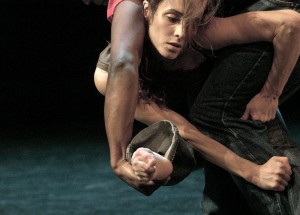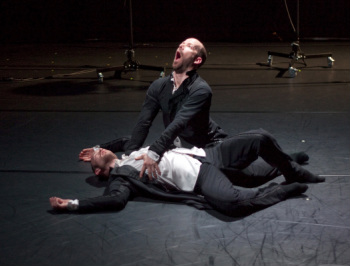by Sedgwick Clark
That’s a traditional reader complaint. But it happens to critics too. Russian violinist Vadim Repin and Lithuanian pianist Itamar Golan have solid careers, and their program last Saturday evening (3/17) in Alice Tully Hall was an enticing selection of works by Janáček, Ravel, Grieg, and Chausson.
From mid-parquet I found Repin’s sound surprisingly coarse and aggressive, as if playing to the last row of Avery Fisher Hall, where he has often performed, rather than the medium-sized Tully. His tone, most deleteriously in Ravel’s jazzy Violin Sonata, was grainy and monochromatic, thick and unsubtle; pizzicatos made scant effect. The same composer’s Tzigane had little gypsy flavor, just headlong virtuosity, and Janáček’s Sonata sounded unaccountably ugly. Chausson’s Poème, which required mostly soft playing, elicited his best moments.
Two seats to my left, The Strad’s Dennis Rooney was filled with praise, although he did suggest that Repin’s violin had problems “in the middle” and would be in the shop next week. Maya Pritsker had been sitting several rows closer and walked back to say hello at intermission, rhapsodizing at how Repin reminded her of David Oistrakh. I reacted with horror and suggested that she stay back with me for the second half. At one particularly unattractive moment in Grieg’s Second Sonata I looked at her and she nodded in understanding; at the end of the work she said he didn’t sound so loud down front.
I was astonished to read Zachary Woolfe’s Times review, stating that “. . . Mr. Repin brought remarkable tone: sweet and focused to the highest reaches of the instrument but never syrupy or heavy. He was game for a wide range of colors—savage attacks and pale whispers—but the atmospherics were less precise and varied: in lyrical passages he tended to be square.” I could agree with only the last part of that sentence.
No movements were listed in the program, which may be why the over-enthusiastic audience applauded between movements—which can’t have helped the performers’ concentration. The stage lighting was distracting as well, throwing shadows on the performers’ faces. A shoddy presentation.
New York Phil Opens Its Archives
Tomorrow (Thursday, 3/22, 10:30 a.m. EST) the NYPhil Archives hosts an “online discussion” of its second release from its steadily burgeoning digital archives: a world-wide discussion of Philharmonic tours from 1943 to 1970. Most important, perhaps, are Leonard Bernstein’s tours with the orchestra to the former Soviet Union, Europe, Japan, and South America. Scholars and musicians from Russia, Japan, Munich, and the United States will join NYP Archivist Barbara Haws and moderator Jeff Spurgeon of New York radio station WQXR for the one-hour event, streamed live via Google Hangout. Click on this link for full info: http://archives.nyphil.org/hangout/
Gil Shaham’s Hartmann
Last week I wrote in anticipation of hearing Karl Amadeus Hartmann’s Concerto funèbre played by Gil Shaham at the Philharmonic and promised a report. It’s not an immediately ingratiating work, and I look forward to the broadcast for further acquaintance. James Keller’s notes mention references to Mahler, Bartók, Stravinsky, Berg, Webern, and Hindemith, and when I went backstage I had to admit that I missed them. Gil’s eyes brightened and he played a passage containing an instantly recognizable quote from Stravinsky’s concerto. He hopes to record the piece, and perhaps my ears will be attuned to Hartmann’s allusions by that time.
MTT’s American Mavericks at Carnegie
My most highly anticipated concerts of the season are upon us: Michael Tilson Thomas’s American Maverick’s series, in celebration of the San Francisco Symphony’s centennial season, the first of which are listed below and will continue through the week. Twentieth-century American masters Ives, Ruggles, Cowell, Varèse, Cage, Feldman, and Adams in the big hall with full orchestra during the coming week. Then on Thursday and Friday in Carnegie’s mid-size Zankel Hall, members of the SFSO will perform works by Harry Partch, Lou Harrison, David Del Tredici (his Syzygy, which Michael told me 40 years ago was a masterpiece), Steve Reich, Lukas Foss, and New York premieres of hot-off-the-press works by Musical America’s 2012 Composer of the Year Meredith Monk, Mason Bates, and Morton Subotnick.
Looking Forward
My week’s scheduled concerts:
3/21 Rockefeller University. Rachel Barton Pine, violin. Paganini: Caprices (24).
3/25 Avery Fisher Hall at 3:00. Murray Perahia, piano. Bach French Suite No. 5. Beethoven: Sonata No. 27, Op. 90. Brahms: Klavierstücke, Op. 119. Schubert: Sonata in A, D. 664. Chopin: Polonaise in C-sharp minor; Prelude in F-sharp minor; Mazurka in C-sharp minor; Scherzo in C-sharp minor.
3/25 Zankel Hall at 7:30. Ensemble ACJW/David Robertson; Moran Katz, clarinet. Wagner: Siegfried Idyll. Ligeti: Chamber Concerto for 13 Instruments. Adams: Gnarly Buttons. Haydn: Symphony No. 8 (“Le soir”).
3/26 Zankel Hall. So Percussion. Works by Cage, Cenk Ergün, Matmos, Dan Deacon, and Jason Treuting.
3/27 Carnegie Hall. San Francisco Symphony/Michael Tilson Thomas; St. Lawrence String Quartet; Joan La Barbara, Meredith Monk, Jessye Norman, vocalists. Cage: Selections from Song Books. Cowell: Synchrony. Adams: Absolute Jest. Varèse: Amériques.
3/28 Carnegie Hall. San Francisco Symphony/Michael Tilson Thomas; Emanuel Ax, piano. Ruggles: Sun-Treader. Feldman: Piano and Orchestra. Ives: A Concord Symphony (orch. Brant).


